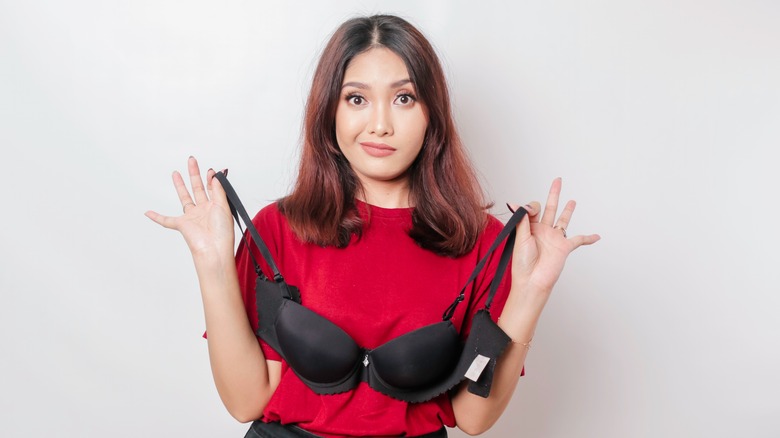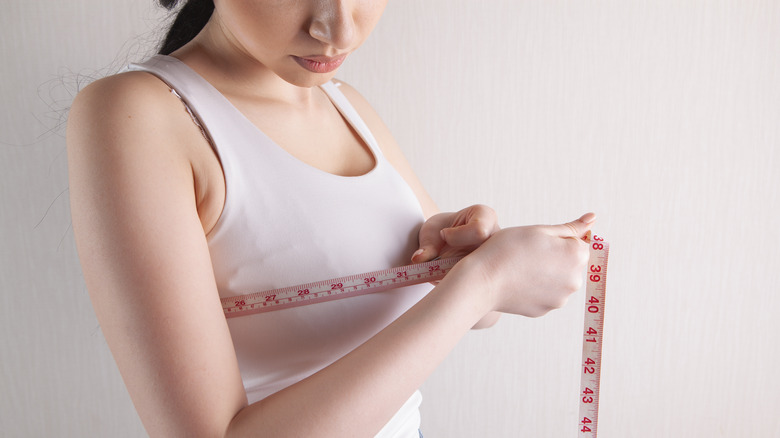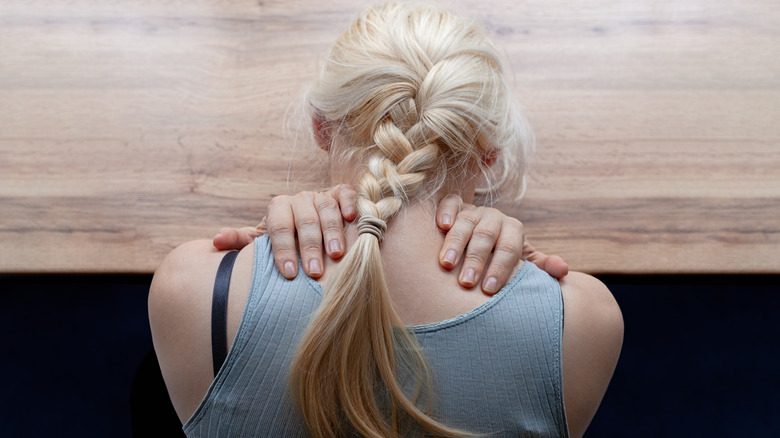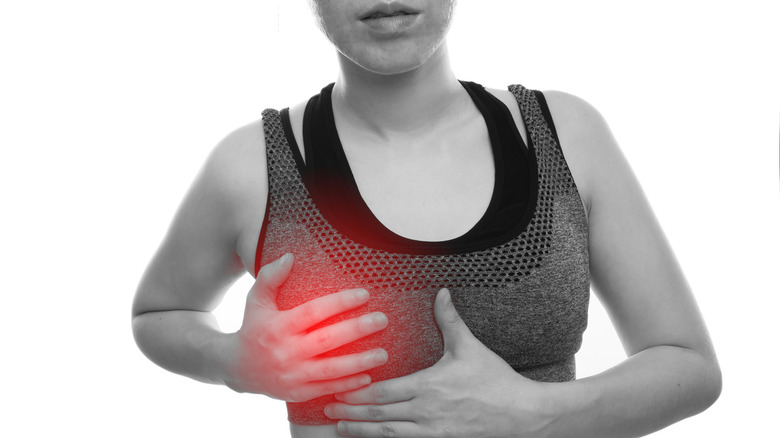What Happens If You Wear A Bra That's Too Small?
We do it all day. When we get a moment, we shift the shoulder straps digging into us. Maybe in the bathroom, we'll lean over to pull our girls back above the underwire. By the end of the day, sometimes our back or neck hurts. If this sounds familiar to you, it might mean you are wearing a bra that's too small. The person who measures you at the store might look like a professional, but according to The Conversation, many of them aren't qualified to measure for a bra. After all, we're usually measured while wearing the wrong-sized bra, to begin with.
When we wear an ill-fitting bra, it can lead to back and neck pain, according to a 2018 study in Orthopaedic Proceedings. Our bras bear a lot of weight, and we often believe that tightening the straps might help keep us feeling supported. But this can put a permanent dent into our shoulder, according to a 2007 study in Plastic and Reconstructive Surgery. Too much gravity can sag the skin around the breast, particularly if you've just had breast surgery, according to a 2017 study in Clinical Biomechanics. A 2015 study in the Journal of Physical Activity and Health found that 17% of women said their breasts prevented them from exercising because they couldn't find a good sports bra or were embarrassed by the excess movement.
How do I find the right bra size?
To find the right bra size, use a measuring tape to measure in inches the circumference underneath your breasts, according to Healthline. The tape should be what optimal tightness might be for the band of your bra. Whatever that number was, add four to find your band size. If it's an odd number, size it up to an even number. Using that same measuring tape, wrap it around your chest at the fullest part of your breast, even if you need to lean over a bit. Subtract your band size from that number to find your cup size. Each inch above your band size increases your cup size. For example, if your band size is 32 and the measure around the fullest part of your breast is 35, your bra size is 32C.
You can determine how well your bra fits from this approach from The Conversation. The band shouldn't move when you jump around because the band is ultimately what gives you support. The shoulder straps shouldn't dig into your shoulders or slip off your shoulders. The cup is too small if your breast spills over, but it's too large if there's a gap between you and the cup. The center of the bra should fit flat against your chest. If it doesn't, the bra is too small. Finally, push into the underwire to see if it squishes any breast tissue, which it shouldn't.
Abrasions, chafing, and more
In a research survey issued to more than 1,000 people in Britain, lingerie company Pour Moi discovered that more than one-quarter of women had never been fitted for a bra, reports the New York Post. That's a lot of people potentially wearing a too-small brassiere. Wearing a poorly-fitting bra can leave its mark in more ways than one. In fact, bras that are too small may not only leave indentations in the shoulders and chest, but may also cause acne breakouts or stretch marks on the surrounding skin.
The survey research also revealed that 37% of women experienced another particularly uncomfortable side effect of wearing a too-small bra: chafing. Reinforcing these findings, experts at Oahu Spine Rehab state that bra band material that digs too deeply into the skin can leave abrasions. Similarly, scarring can also occur within the breast tissue from the continuous rubbing of underwire against the skin if one's bra cups are too small.
Nipple fissures from too-small sports bras
But it's not just the skin surrounding the breast that can become irritated from a bra that's too small. The breast itself can be affected too — specifically, the nipples, notes WebMD. As per the Cleveland Clinic, our nipples can experience pain, soreness, and often cracking in connection with breastfeeding (chestfeeding). These are known as nipple fissures. Not just exclusive to breastfeeding alone, however, nipple fissures can develop in response to friction as well.
Because friction between our nipples and our clothing can occur more readily during physical activity, it's important to get a properly-fitted sports bra, in addition to your everyday bras. Experts at the Cleveland Clinic suggest wearing a sports bra that fits securely but isn't too small or too tight. Additionally, stick with soft materials that are free of seams running down the front of the cup. Seams can press right up against the nipple if your sports bra is too small and can exacerbate rubbing. As an alternative, create a barrier between your nipple and the fabric by covering your nipples with gauze before exercise. Beyond that, Fleet Feet suggests doing away with old sports bras that are more than a year old.



